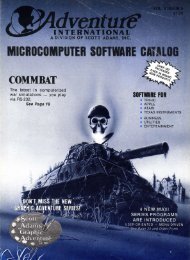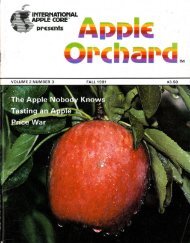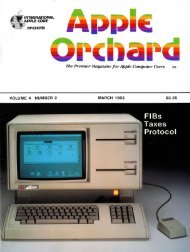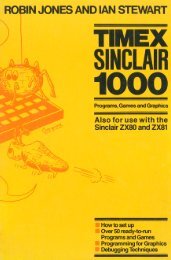You also want an ePaper? Increase the reach of your titles
YUMPU automatically turns print PDFs into web optimized ePapers that Google loves.
Ask Us/<br />
Tell Us<br />
Address your questions, answers, and<br />
comments to:<br />
Apple Orchard<br />
908 George Street<br />
Santa Clara CA 95050<br />
We recently installed a small computer<br />
system in our (medical) office. Paper·<br />
work is down, b~t some of our patients<br />
seem less friendly toward us. How com·<br />
mon is this? Can it be lessened? - T.<br />
G., Los Angeles<br />
Once you have a computer system in<br />
your office or store you will notice a<br />
problem you probably did not anticipate.<br />
Your computer is getting in the way of<br />
secretary-patient or clerk-customer<br />
contact<br />
This relationship degenerates when<br />
the patient talks to your employee, who,<br />
at intervals takes time out to bang on the<br />
keyboard. The patient or customer is left<br />
watching the unattractive back of the<br />
computer terminal, a foreign, threating<br />
experience at best It may be practical for<br />
two staff members to handle this pro·<br />
blem: one person talks to the patient<br />
keeping eye contact while the other enters .<br />
data in to the computer.<br />
Another technique is to avoid putting<br />
the computer between the patient and<br />
staff member. Position the terminal on<br />
the side of the desk/ counter. This allows<br />
the patient to directly watch your staff and<br />
be watched in turn.<br />
A third technique is to have a small<br />
monitor facing the patient or customer,<br />
and requesting that he or she check the<br />
data for accuracy as it is entered. Thus,<br />
the client participates. We'd be happy to<br />
hear about any other solutions. - Ellis J.<br />
Neiburger, D.D.S.<br />
My activity at times requires me to send<br />
textfiles over a modem, usually on the<br />
Source. These files should have a car·<br />
riage return at least every 80 characters,<br />
but my Apple Writer/// files don't have<br />
those returns because they're justified<br />
on printout Is there any way I can put in<br />
those carriage returns without having to<br />
do it one at a time? - L F., Anderson, IN<br />
6 Apple Orchard<br />
Yes, there is. While it's not highlighted<br />
as a feature, Apple Writer / / / (and a<br />
number of other word processors) can<br />
be made to print to a Disk ASCII file<br />
instead of a printer, with the format,<br />
including carriage returns, inserted as for<br />
a printer. One hitch with Apple Writer: the<br />
target file name must already be present<br />
in the directory when you do this. So, first<br />
SA VE the file to disk under its " print"<br />
pathname (e.g., " .d2/ PRINTL TR" . Must<br />
be different from the storage name). Now<br />
use CTRL· P, set the print parameters ( LM<br />
0, RM 75, etc.) and replace the print<br />
destination (PD) ".PRINTER" with the<br />
" print" file pathname. At that point, you're<br />
" modifying" the "print" file.<br />
Clear memory and Load the " print"<br />
file. If you make the carriage returns<br />
visible (CTRL·Q;6) you'll see the fomat·<br />
ted document That's sometimes helpful<br />
as a preview too. When transmission time<br />
comes, send the " print" file. -P.C.<br />
Weiglin<br />
We got a computer system that was<br />
touted to do eveiything. It falls short of<br />
our expectations. Shall we junk it? How<br />
do we go back to manual simplicity? -<br />
F. K., Chicago<br />
First, consider that just because you<br />
have been using a full system, you must<br />
de-computerize completely, even though<br />
your frustrations impel you in that direc·<br />
tion. Better to take a few steps back.<br />
Instead of doing all your office functions<br />
via computer, do only a few . . . like client<br />
mailing lists or word processing, appoint·<br />
ments, etc. There is no rule that requires<br />
you to use the computer for every func·<br />
tion. Just sit back and get a simple<br />
program or two and use it Perhaps<br />
sometime in the future there will appear a<br />
full office program that you can use and<br />
enjoy ... but until then, you can still bene·<br />
fit from computerization.<br />
What happens when your system works<br />
perfectly but the hardware has glitches<br />
that render life unpleasant? Cut out the<br />
defective unit, wind down and sit back<br />
until a functioning improvement or re·<br />
"placement is made . . . then get it and<br />
start up.<br />
The important key is that computeriza·<br />
tion is for your benefit and when it ceases<br />
to work well ... change. You are not<br />
committed to use your system all the<br />
time and times do change. If it pays to<br />
stop computerizing for a while, do so. You<br />
will be able to pick things up a little later<br />
on. - Ellis J. Neiburger.<br />
BASIC Compare 111<br />
BASIC Compare Ill is a program<br />
which will permit you to compare<br />
two Apple Ill Business BASIC programs<br />
(preferably two versions of<br />
the same program) and print the<br />
differences on a printer, display on<br />
a console, or send to disk. If you do<br />
much programming, you will soon<br />
find out how useful this can be,<br />
especially if you follow the good<br />
programming practice of not overwriting<br />
the old version of a program<br />
with the new.<br />
Requires Apple Ill Business<br />
BASIC. Program by Mike Kramer.<br />
Send $25.00 to:<br />
908 George Street<br />
Santa Clara, CA 95050<br />
61/2% Sales tax for California Residents







